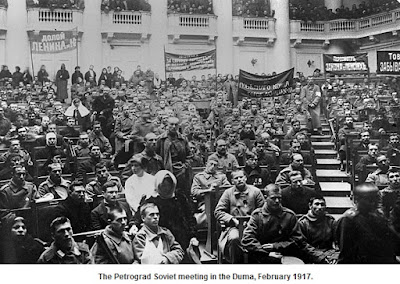The
February Revolution in Petrograd
In the winter of 1917, conditions in the capital,
Petrograd, were grim. The layout of the city seemed to emphasise the divisions
among its people. The workers’ quarters and factories were located on the right bank of the River Neva. On the left bank were the
fashionable areas, the Winter Palace, and official buildings, including the
palace where the Duma met. In February 1917, food shortages were deeply felt in the workers. quarters. The winter was very cold .
there had been exceptional frost and heavy snow. Parliamentarians wishing to preserve
elected government, were opposed to the Tsar’s desire to dissolve the Duma.
On 22 February, a lockout took place at a factory on
the right bank. The next day, workers in fifty factories called a strike in
sympathy. In many factories, women led the way to strikes.This came to be
called the International Women’s Day. Demonstrating workers crossed from
the factory quarters to the centre of the capital - the Nevskii Prospekt. At
this stage, no political party was actively organising the movement. As the fashionable
quarters and official buildings were surrounded by workers, the government
imposed a curfew. Demonstrators dispersed by the evening, but they came back on
the 24th and 25th. The government called out the cavalry and police to keep an
eye on them.
On Sunday, 25 February, the government suspended the
Duma. Politicians spoke out against the measure. Demonstrators returned in
force to the streets of the left bank on the 26th. On the 27th, the Police
Headquarters were ransacked. The streets thronged with people raising slogans
about bread, wages, better hours and democracy. The government tried to control
the situation and called out the cavalry once again. However, the cavalry
refused to fire on the demonstrators. An officer was shot at the barracks of a
regiment and three other regiments mutinied, voting to join the striking
workers. By that evening, soldiers and striking workers had gathered to form a ‘soviet’
or ‘council’ in the same building as the Duma met. This was the Petrograd
Soviet. The very next day, a delegation went to see the Tsar. Military commanders
advised him to abdicate. He followed their advice and abdicated on 2 March.
Soviet leaders and Duma leaders formed a Provisional Government to run the
country. Russia.s future would be decided by a constituent assembly, elected on
the basis of universal adult suffrage. Petrograd had led the February
Revolution that brought down the monarchy in February 1917.

No comments:
Post a Comment